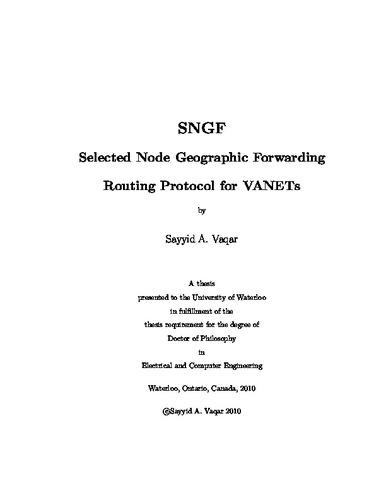| dc.contributor.author | Vaqar, Sayyid | |
| dc.date.accessioned | 2011-01-31 17:49:49 (GMT) | |
| dc.date.available | 2011-01-31 17:49:49 (GMT) | |
| dc.date.issued | 2011-01-31T17:49:49Z | |
| dc.date.submitted | 2010 | |
| dc.identifier.uri | http://hdl.handle.net/10012/5782 | |
| dc.description.abstract | This thesis presents a protocol for intervehicle communication for use in Vehicular
Ad Hoc Networks (VANET). VANET is a natural extension of mobile ad
hoc networks (MANET) in which the restrictions related to power and mobility
are relaxed. The routing protocols used for MANETs are generally dependent on
the state of the network. With changes in the network topology, routing messages
are generated so that the states of the routers in the network are updated. In
the case of VANETs, in which the level of node mobility is high, message-routing
overhead has serious implications for the scalability and throughput of the routing
protocol.
This thesis introduces criteria that are recommended for use when protocols
are designed for VANET applications and presents the Selected Node Geographic
Forwarding (SNGF) protocol. The SNGF protocol implements controlled flooding
in an efficient manner in order to reduce unnecessary communication overhead.
The protocol has a destination discovery mechanism that allows it to initiate
correspondence between nodes without reliance on static location services. The
protocol avoids formation of clusters by using the concept of selective forwarding,
thus providing the advantages of cluster based approaches without actually
forming one itself. It effectively deals with blind flooding by introducing a comprehensive
retransmission time delay in the nodes. This retransmission delay
favors the nodes in the direction of the destination and prevents other nodes
from retransmitting the same message. The SNGF protocol does not use routing
tables, which require frequent updates in mobile networks, instead it relies on directing the messages to geographic locations which are forwarded by any
available intermediary nodes. The protocol also provides techniques for handling
network fragmentation which can be a frequent problem in vehicular networks.
It is capable of delayed message transmission and multiple route discovery in the
case of the non-availability of the shortest path to the destination.
To evaluate the performance of the SNGF protocol, an extensive study of
mobile networks was conducted using the NS2 simulator. The simulation results
demonstrate the reachability of the protocol, its scalability advantages and its
total independence from location services.
The SNGF protocol allows each participating node to operate independently
of other nodes in the network. Nodes in the network are able to communicate
with other nodes without ever becoming dependent on intermediary nodes. This
feature opens new possibility for individual node based application development
in ad hoc networks. The traffic profiling is described as it would be observed by an
independent node participating in VANET using the SNGF protocol. The node
communicates with other nodes and collects relevant data through the discourse
capability of SNGF. The data collected by the node is viewed as a snapshot in
time of the traffic conditions down the road based upon which future traffic condition
is predicted. Traffic profiling is investigated for different levels of VANET
deployment. The simulation results show that the proposed method of traffic
profiling in a VANET environment using the SNGF protocol is viable for even
lower levels of deployment. | en |
| dc.language.iso | en | en |
| dc.publisher | University of Waterloo | en |
| dc.subject | VANET | en |
| dc.subject | Routing | en |
| dc.subject | Protocol | en |
| dc.subject | Traffic Profiling | en |
| dc.title | SNGF Selected Node Geographic Forwarding Routing Protocol for VANETs | en |
| dc.type | Doctoral Thesis | en |
| dc.pending | false | en |
| dc.subject.program | Electrical and Computer Engineering | en |
| uws-etd.degree.department | Electrical and Computer Engineering | en |
| uws-etd.degree | Doctor of Philosophy | en |
| uws.typeOfResource | Text | en |
| uws.peerReviewStatus | Unreviewed | en |
| uws.scholarLevel | Graduate | en |

